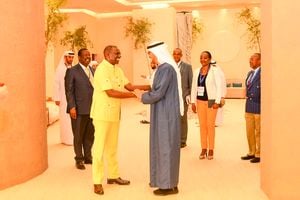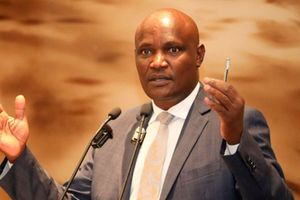
A geothermal power facility and high voltage electricity lines at Olkaria Geothermal Power Station in Naivasha.
The $736.51 million (Sh95 billion) proposal by Indian conglomerate Adani Group to construct three high voltage power transmission lines and two substations is the latest in a long list of big-money deals and projects in Kenya’s electricity sector that have raised eyebrows.
Adani Energy Solutions Limited, a subsidiary of the Adani Group, is one of three foreign companies that have submitted privately-initiated proposals to build power lines.
However, its proposal has elicited more scrutiny from the public as Adani is also involved in a controversial $2 billion (Sh258 billion) takeover bid of the Jomo Kenyatta International Airport (JKIA).
Further, Adani’s global image has been tainted after accusations of corruption and fraud by authorities in Australia and Switzerland respectively, raising eyebrows among Kenyans about the company. The Indian conglomerate has, however, consistently denied any wrongdoing
Adani is seeking to recoup Sh634.7 billion ($4.92 billion) over the next 30 years from building power transmission lines in Kenya should its proposal be accepted by the Kenya Electricity Transmission Company (Ketraco).
In its counter proposal Ketraco wants to hand Adani an annual revenue of $104.48 million (Sh13.48 billion) per year, which translates to $3.134 billion (Sh404.33 billion) over the 30-year period.
The two are currently haggling over the final figures that will be acceptable to both parties.
The controversy over the proposed Ketraco-Adani deal has thrust Kenya’s power energy sector parastatals into the spotlight once again.
Over the years, the sector has been at the centre of controversial deals that have made Kenyans weary of big deals that could lead to loss of funds and higher cost of goods and services.
Shady procurements at public utility Kenya Power have in the past hit Kenyans with thousands of faulty transformers that blow up leaving many in the dark.
Former top officials at Kenya Power have been indicted in the past for buying such transformers in multi-million shilling deals. In 2021, 59 officials in the company’s procurement department were suspended to pave way for a forensic audit into the team’s operations.
They would later resume their positions following the suspension, while the findings and in extension recommendations of the forensic audit of the officials have never been made public.
This has cast questions over the procurements at the utility and how top officials have over the years used their powerful positions at the firm to influence winners of lucrative tenders.
Samuel Gichuru, a former CEO at the firm, and Chris Okemo, a former Cabinet minister, were also indicted in Jersey where they were charged with 53 counts linked to “commissions” paid by companies to win tenders at the utility.
Kenyans still have painful memories of paying billions of shillings in penalties for delays in the construction of the 428 kilometre 400kV high voltage power transmission line from Loiyangalani in Marsabit to Suswa in Narok.
According to a special audit done by Auditor-General Nancy Gathungu and whose findings were released in April 2021, Kenyans paid a penalty of Sh18 billion for a 21-month delay in the construction of the line.
The genesis of the story is Lake Turkana Wind Power (LTWP), a privately-owned independent power producer (IPP), had signed a long-term contract with Kenya Power for supply of electricity from a 310MW wind power plant the firm was to build in Marsabit.
At the time, there was no transmission line to evacuate the power from Loiyangalani. Interestingly, LTWP, the company that would be the ultimate beneficiaries in any delayed completion of the line, was involved in the procurement of the contractor to build the line.
“They were involved in part of the procurement process, supposedly on behalf of KPLC for Lot 3; 400kV transmission line from Loiyangalani to Suswa, which was a red flag and potential conflict of interest,” said Ms Gathungu.
The contractor would subsequently delay the completion of the line by 21 months, leading to the penalties for deemed generated energy (DGE).
A investigation by the National Assembly’s Public Investments Committee revealed that the outstanding amounts from the claims related to the project continue to accrue interest to date, exposing taxpayers to more losses.
Further, Parliament questioned why the project was not subjected to competitive bidding despite being one of Kenya’s least cost power projects and having a medium to long term beneficial value for electricity generation in Marsabit.
“The process was undertaken through a specially permitted procurement procedure that was approved by Dr Kamau Thugge, then PS at the National Treasury,” said the Committee’s report.
Former President Uhuru Kenyatta faced immense public pressure to cut power costs, forcing him to announce a 15 per cent tariff reduction in January 2022 that hit Kenya Power.
The former President also targeted Independent Power Producers (IPPs), but most of them stood their ground and refused to cut tariffs. Parliament has revealed that the cost of terminating the contracts of the 13 IPPs would see taxpayers fork out Sh264 billion in compensation.
But the element that has been lost in this discussion is what is the root cause of the high cost of power. The Auditor-General has pointed out high capacity charges as one of the main reasons why consumers are paying high power bills.
Ms Gathungu notes that during the two years (2020/21 and 2021/22), capacity charges were higher than the cost of the actual energy purchased during the period. A capacity charge is a cost charged by IPPs to have ready capacity to discharge power to the grid whenever called upon.
Consumers must pay this charge regardless of whether the IPP has generated power or not. In the FY2019/20, consumers paid a capacity charge of Sh47.5 billion. In the following year, it increased to Sh49.2 billion.
The many taxes and levies on electricity also contribute to the high power bills. There are eight components in the power bill including consumption charge, fuel energy cost (FEC), forex charge, inflation adjustment, and Value Added Tax .
Others are Rural Electrification Programme (REP) levy, Epra levy and water levy.
Kenya is one of the leading geothermal power producers in the world, with the Geothermal Development Company (GDC) specially set up in 2008 to exclusively exploit the resource that is estimated at 10,000MW in the country.
However, MPs have raised questions over how GDC is undertaking this role. The National Assembly’s Public Investment Committee recently revealed that GDC has Sh4.4 billion worth of unused supplies and equipment at its geothermal field in Menengai.
The audit report also highlighted that steam wells capable of generating 300MW of power are sitting idle due to delays in finding investors to set up power plants at the sites despite costing billions of shillings to dig.
The power sector has also been riddled with allegations of cronyism, where well-connected individuals including high ranking politicians have been linked to big-money power generation deals.









